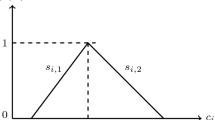Abstract
Classical mathematical programming models require well-defined coefficients and right hand sides. In order to avoid a non satisfying modeling usually a broad information gathering and processing is necessary. In case of real problems some model parameters can be only roughly estimated. While in case of classical models the vague data is replaced by "average data", fuzzy models offer the opportunity to model subjective imaginations of the decision maker as precisely as a decision maker will be able to describe it. Thus the risk of applying a wrong model of the reality and selecting solutions which do not reflect the real problem can be clearly reduced. The modeling of real problems by means of deterministic and stochastic models requires extensive information processing. On the other hand we know that an optimum solution is finally defined only by few restrictions. Especially in case of larger systems we notice afterwards that most of the information is useless. The dilemma of data processing is due to the fact that first we have to calculate the solution in order to define, whether the information must be well-defined or whether vague data may be sufficient. Based on multicriteria programming problems it should be demonstrated that the dilemma of data processing in case of real programming problems can be handled adequately by modeling them as fuzzy system combined with an interactive problem-solving. Describing the real problem by means of a fuzzy system first of all only the available information or such information which can be achieved easily will be considered. Then we try to develop an optimum solution. With reference to the cost-benefit relation further information can be gathered in order to describe the solution more precisely. Furthermore it should be pointed out that some interactive fuzzy solution algorithms, e.g. FULPAL provide the opportunity to solve mixed integer multicriteria programming models as well.
Similar content being viewed by others
References
Fandel,G.(1994).PPS-Systeme:Grundlagen,Methoden,Software,Marktanalyse.Heidelberg: Springer-Verlag.
Kivija ¨rvi, H.,P.Korhonen,and J.Wallenius.(1986).''Operations Research and its practice in Finland,'' Interfaces 16,53-59.
Lilien,G.(1987).''MS/OR:A mid-life crises,''Interfaces 17,53-59.
Meyer zu Selhausen, H.(1989).''Repositioning OR 's Products in the Market,''Interfaces 19,79-87.
Rommelfanger,H.(1991).''Stochastic Programming with Vague Data,''In Annales Universitatis Sci-entiarum Budapestinensis de Rolando Eo ¨tvo ¨s Nominatae Sectio Computatorica 12,213-221.
Rommelfanger,H.(1994).-Fuzzy Decision Support-Systeme-Entscheiden bei Unscha ¨rfe,Berlin, Heidelberg: Springer-Verlag.
Rommelfanger,H.(1995).''FULPAL 2.0-An Interactive Algorithm for Solving Multicriteria Fuzzy Linear Programs Controlled by Aspiration Levels,''In D.Schweigert (ed.),Methods of multicriteria decision theory.Pfalzakademie Lamprecht,21-34.
Rommelfanger,H.(1989).Inequality Relations in Fuzzy Constraints and its Use in Linear Fuzzy Opti-mization.In:J.-L. Verdegay and M.Delgado (Eds.):The Interface between Arti cial Intelligence and Operational Research in Fuzzy Environment.Ko ¨ln: Verlag TU ¨V Rheinland,195-211.
Rommelfanger,H.(2000).''Interactive fuzzy-project planning with.exible extended addition,''In D.Ruan et al.(eds.),Intelligent Techniques and Soft Computing in Nuclear Science and Engineering, Singapore: World Scienti c Publishing Co.,62-71.
Rommelfanger,H.and T.Keresztfalvi.(1991).''Multicriteria Fuzzy Optimization Based on Yager 's Parametrized T-Norm,''Foundations of Computing and Decision Sciences 16,99-110.
Rommelfanger,H.and R.Slowinski.(1998).''Fuzzy Linear Programming with single or multiple Objective Functions,''In R.Slowinski (ed.),Fuzzy Sets in Decision Analysis,Operations Research and Statistics,Dordrecht: Kluwer Academic Publishers,179-213.
Simon, H.A.(1955).''A behavioral model of rational choice,''Quarterly Journal of Economics 69,99-118.
Tingley, G.A.(1987).''Can MS/OR sell itself well enough?,''Interfaces 17,41-52.
Yager, R.R.(1980).On a general class of fuzzy connectives.Fuzzy Sets and Systems 3,235-242.
Zadeh, L.A.(1965).''Fuzzy Sets,''Information and Control 8,338-353.
Author information
Authors and Affiliations
Rights and permissions
About this article
Cite this article
Rommelfanger, H. The Advantages of Fuzzy Optimization Models in Practical Use. Fuzzy Optimization and Decision Making 3, 295–309 (2004). https://doi.org/10.1007/s10700-004-4200-6
Issue Date:
DOI: https://doi.org/10.1007/s10700-004-4200-6




